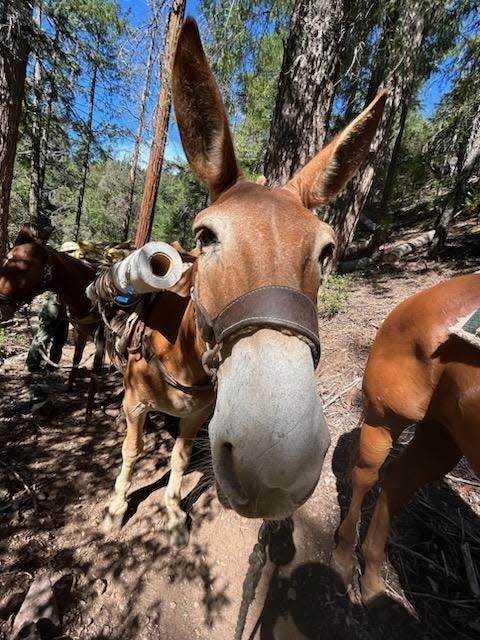Mules, horses give an assist to forest service crews fighting wildfires in Trinity County
Modern firefighters use high-tech drones to monitor fires, sophisticated aircraft to patrol burn areas and GPS to share dangerous locations in the blink of an eye.
They also use old-school mules.
Fire crews are relying on low-tech mules as they tackle remote wildfires fires in the far North State.
Firefighters with the U.S. Forest Service are relying on hairy help to battle the Deep Fire in Trinity County. Crews are riding the horses and using mules to carry firefighting equipment, food and other supplies to sites near wildfires.
More: California AG: Anderson's 'copy-cat' gender identity policy violates state Constitution
The sure-footed equines can carry loads into canyons and other places where there’s steep terrain, often where smoke from wildfire above the area is too thick for aircraft to see a clear path to the ground, Shasta-Trinity National Forest spokesperson Ruth Esperance said.
Mules are well built to navigate steep ground while carrying 150 to 200-pound loads in their packs, according to the forest service’s Wilderness and Trails Program Manager Mike McFadin.
Although firefighting techniques have evolved since the forest service’s founding in 1905, the relationships forged between fire crews and their mules and horses never ended, Esperance said.
Note to readers: If you appreciate the work we do here at the Redding Record Searchlight, please consider subscribing yourself or giving the gift of a subscription to someone you know.
The animals are an important part of fighting fires in Northern California, she said. “Inversions are a common occurrence, meaning that smoke from the fires will lay in the drainages and make visibility difficult, if not impossible,” said Esperance.
In those cases, when aircraft pilots can’t see where to drop equipment and firefighters, "that is where our mules and horses can come in and play a part in fire-suppression efforts,” Esperance said.
They're also a more economical way to get supplies to remote locations, forest service staff said. "We're probably saving $100,000 worth of helicopter time with these mules" on the Deep Fire, McFadin said.
The Shasta-Trinity National Forest keeps 30 mules and five horses. The forest service rotates the animals' shifts so they have plenty of time to rest between jobs, Esperance said.
They also have three full-time staff, called packers, and several helpers who plan and pack up what the animals carry into the wilderness. The animals learn to trust the people who lead them — so much so, they follow them into wildfire areas, she said.
Mules are especially strong and social creatures, McFadin said.
Other national forests use mules and horses, too. The forest service’s Pacific Southwest Region has its own pack animal string, as does Lolo National Forest in western Montana, Esperance said.
Their charm isn't lost on Trinity County residents.
Shasta-Trinity National Forest’s mules and horses have their own Facebook fan page, ostensibly hosted by Ivan, the government pack mule. In reality, posts are populated by McFadin out of the Forest Service’s barn and corral in Weaverville ― although McFadin insists, jokingly, that Ivan goes through a lot of keyboards trying to type posts on Facebook.

Ivan is a real mule who has been with the Shasta-Trinity Forest for 11 years.
When he arrived, he had an injury. McFadin forged a friendship with Ivan while helping the mule through physical therapy. Ivan is "a bruiser," McFadin said of the robust mule.
And very clever, McFadin said: "He's like that really smart kid at school who gets awful when he's bored. He'll pull tricks on the other mules and packers. He's been known to go through saddlebags and selectively go through your lunch."
The wily mule uses his mouth to open locks on gates ― not to escape, just to go through them, turn around and stare at people defiantly, McFadin said.
McFadin further immortalized Ivan in 2016, when he wrote a children’s book, “Ivan the Forest Service Pack Mule.” Illustrated by retired forest service archeologist Gay Berrien, the book is available at Tammie's Books in Weaverville and online at SmokeyBearGifts.com. Sales from the book sponsor children going to summer camp and help fund educational non-profits that specialize in getting kids outdoors, McFadin said.
McFadin didn't drop spoilers, but promised most of the things Ivan does in the book are antics the mule "has actually done over the years."
While people enjoy reading about the mules and horses and seeing their photos on social media, they’re no petting zoo pets.
These animals are “hard-working employees of the U.S. Forest Service,” not typical mules or horses you’d find on a family ranch. They're out with firefighters eight months a year, Esperance said. "They work hard for the taxpayer and so much work gets done with their help,” she said.
Jessica Skropanic is a features reporter for the Record Searchlight/USA Today Network. She covers science, arts, social issues and news stories. Follow her on Twitter @RS_JSkropanic and on Facebook. Join Jessica in the Get Out! Nor Cal recreation Facebook group. To support and sustain this work, please subscribe today. Thank you.
This article originally appeared on Redding Record Searchlight: Some forest service crews ride horses to fires in California mountains
